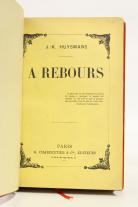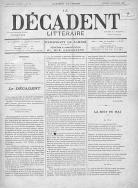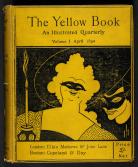Oscar Wilde and French Decadence
Created by Brooke Eubanks on Sat, 04/24/2021 - 22:07
A short timeline outlining the most prominent moments of the Decadent Movement as it pertains to Oscar Wilde.
Timeline
Chronological table
| Date | Event | Created by | Associated Places | |
|---|---|---|---|---|
| May 1884 |
Joris-Karl Huysmans' (1848-1907) novel À Rebours is published.In English, the title translates to Against Nature or Against the Grain. It is considered the embodiment of decadence, often associated with the Decadent Movement. It focuses on sensory experiences. There is one character in the novel, a hero named Jean Des Esseintes––a late nineteenth-century, aristocratic writer. He considers the modern, aristocratic world he lives in as anti-creativity and pro-productivity; therefore, rejects modernity to lead a life devoted to beauty. The significance of him being the only character is related to the Decadent Movement’s positive opinion of social isolation, which allows for psychological alienation. As for Oscar Wilde (1854-1900), it is noted to have inspired The Picture of Dorian Gray (1890) and to be the "poisonous French novel" Dorian Gray is given by Lord Henry. Wilde admired the text and inspired other British Aesthetes and Decadents.
Doyle, Natalie. “Against Modernity: the Decadent Voyage in Huysmans' A Rebours.” Romance Studies, vol. 11, no. 1, 1993, pp. 15–24., doi:10.1179/ros.1992.11.1.15. Porter, Laurence M. “Huysmans' ‘A Rebours’: The Psychodynamics of Regression.” American Imago, vol. 44, no. 1, 1987, pp. 51–65. JSTOR, www.jstor.org/stable/26304095. |
Brooke Eubanks | ||
| 10 Apr 1886 to 15 Apr 1889 |
Anatole Baju (1861-1903) founded the newspaper Le Décadent.Le Décadent––originally published under the name of The Literary & Artistic Decadent––was a French literary magazine directed and founded by Anatole Baju. Paul-Marie Verlaine (1844-1896) was a French poet and contributor, who honors Baju for unifying the French writers under the Decadent Movement through the newspaper. Baju’s intent was to bring the "scattered forces in a single bundle".
Britannica https://www.britannica.com/event/Decadent#ref49944 Le Decadent Archives https://gallica.bnf.fr/ark:/12148/cb34429854b/date1886.r= Verlaine, Paul. “Anatole Baju.” Complete works - Tome V, Vanier (Messein), 1905 (pp. 376 - 383). https://fr.wikisource.org/wiki/Anatole_Baju_(Verlaine). |
Brooke Eubanks | ||
| Apr 1894 to Apr 1897 |
The Bodley Head Publishing House publishes The Yellow Book.The Bodley Head was an independent British publishing house, which took on the defining periodical of 1890s British literature, The Yellow Book. It was associated with decadence and aestheticism. The name is a testament to “the yellow book” in Oscar Wilde’s The Picture of Dorian Gray (1890), which is believed to be Joris-Karl Huysmans's (1848-1907) novel À rebours. It was edited by Henry Harland and Aubrey Beardsley––who illustrated the cover of Oscar Wilde’s (1854-1900) Salome. Wilde did not publish in the periodical; however, after his trial, the periodical was sustained by poetry written by women, who “obliquely expressed sympathy with Wilde” (Hughes). On his way to his first trial, Wilde carried a volume of The Yellow Book, which maintained its association with aestheticism, decadence, and even homosexuality. The periodical had several gay, lesbian, and bisexual contributors among its vast array of literary and artistic genres.
Archive: http://www.1890s.ca/Volumes.aspx?p=The%20Yellow%20Book Hughes, Linda K. "Women Poets and Contested Spaces in The Yellow Book." SEL Studies in English Literature 1500-1900, vol. 44 no. 4, 2004, p. 849-872. Project MUSE, doi:10.1353/sel.2004.0038. Ledger, Sally. "Wilde Women and The Yellow Book: The Sexual Politics of Aestheticism and Decadence." English Literature in Transition, 1880-1920, vol. 50 no. 1, 2007, p. 5-26. Project MUSE, doi:10.1353/elt.2007.0007.
|
Brooke Eubanks |



